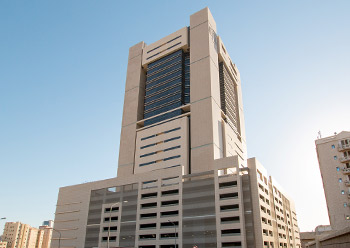Smart Kuwait courts complex ready
Pace, one of the region’s leading architecture and engineering practices, has added another impressive project to its porfolio with the completion of Kuwait’s Hawally Court Complex.
01 March 2021
An imposing court complex in the Hawally area of Kuwait, which was designed by Pace, one of the region’s leading architecture and engineering practices, is now in the process of being handed over.
The Hawally Court Complex for the Ministry of Justice (MOJ) is the latest edition of the smart courts being built in the country.
The new judicial landmark was completed in January by the Ministry of Public Works (MPW) which appointed Pace to undertake the design and construction supervision of the project.
 |
|
The complex includes 52 courts. |
The multi-purpose smart building stands tall 150 m above ground level on a 9,000-sq-m site. Providing an array of court-related services to its occupants, the tower encompasses a built-up area of 146,000 sq m, comprising 52 courts, which includes 40 supreme courts, 12 appeal courts and offices that can accommodate 1,334 employees.
Additionally, the building houses numerous facilities including prison facilities, a law library, archival storage, cafes, prayer rooms, seminar rooms, multi-use auditorium, public waiting, as well as mechanical and service utilities. An adjacent multi-storey car park can accommodate a total of 1,200 parking spaces.
Commenting on the project, Pace’s CEO Tarek Shuaib says: “The new complex, which currently stands as the tallest and one of the largest buildings in the Hawally area, is located within its commercial and administrative district. It aims to provide a larger and more modernised facility in order to accommodate the increasing number of users in Hawally governorate, in addition to minimising congestion at the temporarily existing district court building until it is fully replaced.”
From a design point of view, Shuaib says Pace sought a design that could symbolise the foundations of stability, permanence and stature within a society portraying equality and fairness for all. Externally, the architectural envelope is enhanced by the use of a contemporary interpretation of an Islamic pattern.
 |
|
Hawally Courts Complex’s design blends modernity and Islamic heritage. |
According to Shuaib, the architectural mass makes best use of the site and expresses the gravity and importance expected from a building of this stature. “The surfaces, both glazed and solid, are linked all the way around the building by the use of a pattern in order to reflect a traditional theme in a contemporary manner,” he adds.
Furthermore, Shuaib explains that the main, high mass of the building is square-shaped, which gives it a clear sovereign identity in form and function. He indicates that the judicial tower embraces a central, naturally-lit space hall, which is the focal point of the building, allowing natural lighting to filter deep into the interior floor plates, whilst providing exterior views for the majority of the building’s occupants.
As for its façades, Shuaib points out that its design blends modernity and Islamic heritage in a contemporary framework, represented by the diversity of finishes between the glass covering with an Islamic geometric pattern and the use of granite with a warm and rich sand colour.
“An efficient planning strategy was accomplished in the design that separates the three types of circulation systems required: public, private (judicial) and defendants. Circulation flow was also carefully studied and designed to ensure harmony and integrity among main entrances and exits and specified emergency exits. The design team also chose a harmonious and calm interior design that used a group of distinctive materials and materials, which vary between stone, ceramic, mosaic and luxurious wood cladding, noting that the priority was given to the use of long-term and environmentally friendly materials,” he adds.
 |
|
Hawally courts complex houses numerous facilities. |
The complex’s multi-levelled car park building consists of five floors with three basements and a mezzanine. Secure parking spaces are separated from public parking and include 53 parking spaces for judges, 50 for general prosecutors and 40 VIP parking spaces.
The new Hawally Courts Complex is also equipped with smart and modern systems, as well as clean energy systems that save on electrical energy consumption, Shuaib says, adding that project has been delivered in accordance to the highest standards of quality and design excellence.
Pace has delivered most of the country’s smart judicial edifices, including the award-winning Farwaniya and Jahra Court Complexes, the firm is also in the process of delivering the new Palace of Justice of Kuwait.
The Palace of Justice is expected to be the largest judicial building in the Middle East once completed. Located in the heart of Kuwait City, the project covers an area of 33,384 sq m. The landmark building, overlooking the Arabian Gulf, will have more than 141 courtrooms and around 131,000 sq m of office space spread over 26 floors.
- Biodiversity focus at Red Sea
- Smart Kuwait courts complex ready
- High-end floating villas set for launch



